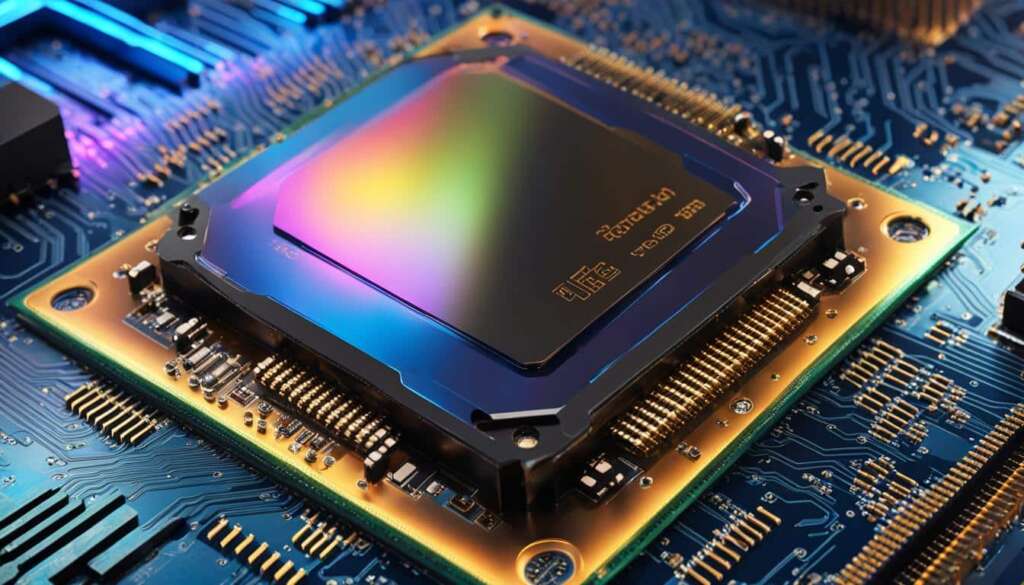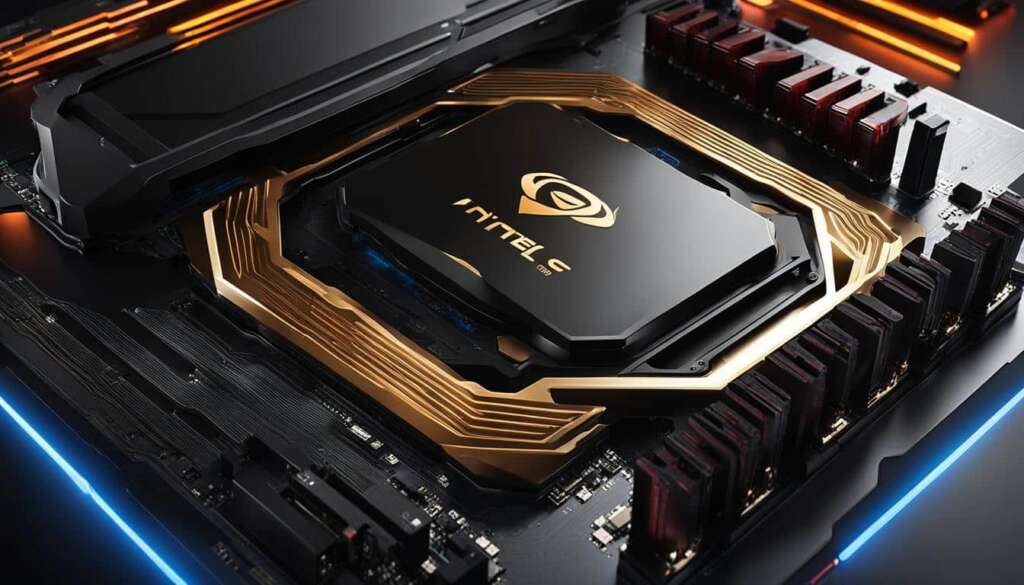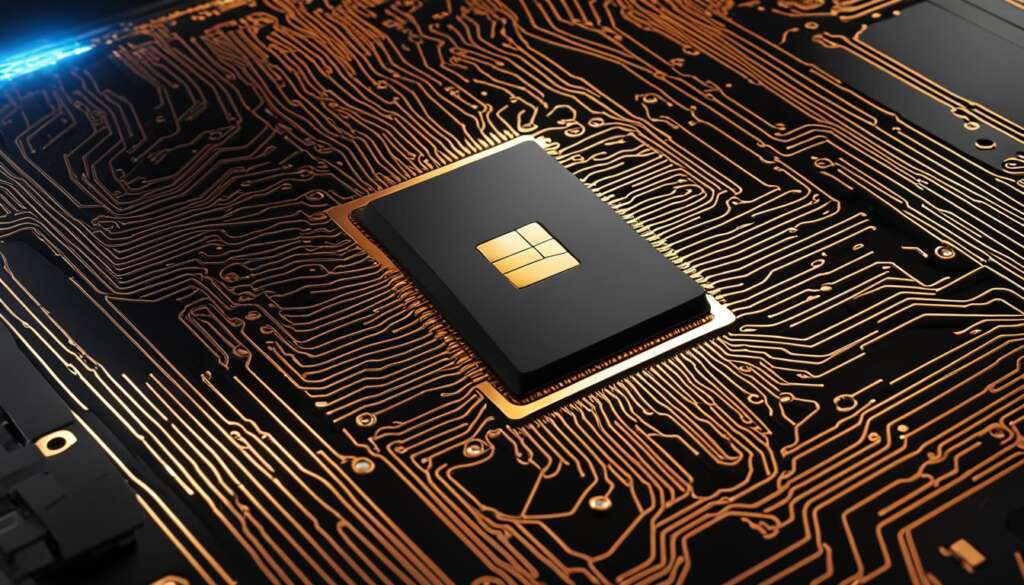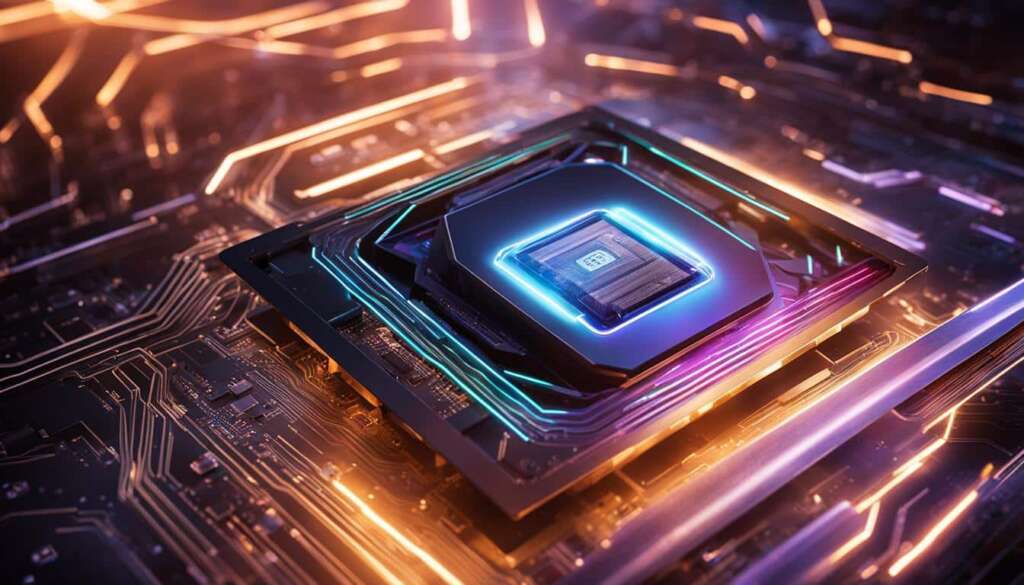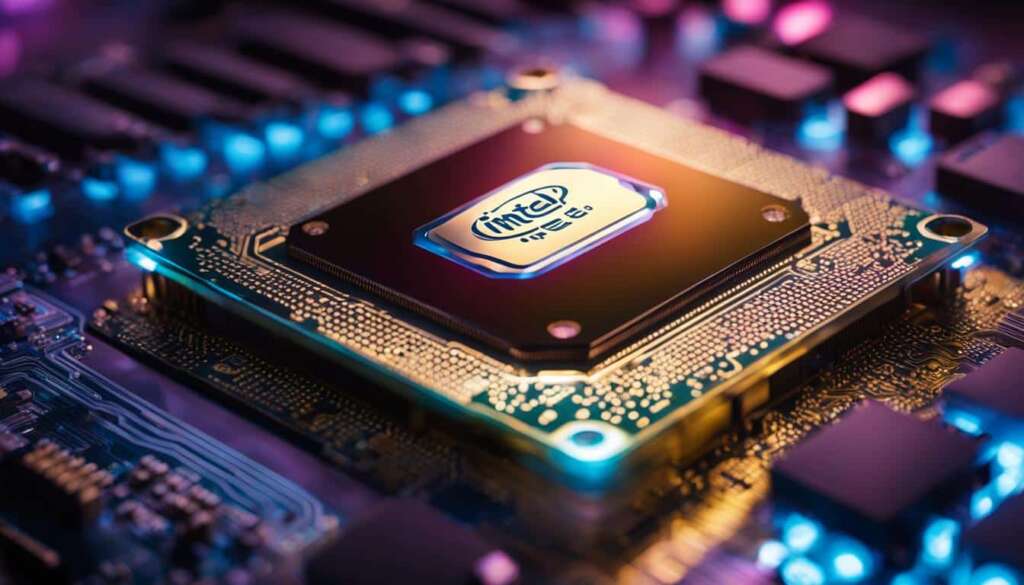Table of Contents
Intel, the renowned chip manufacturer, has recently unveiled its latest range of processors, offering cutting-edge performance and advanced features for a variety of computing needs. The newest Intel processors, including the 14th Generation Core series, are set to revolutionize the industry with their unmatched capabilities. Whether you’re a gamer in need of powerful processing, a business professional looking for enhanced performance, or a casual computer user seeking an upgrade, Intel has the perfect solution for you.
Featuring the high-end Core i9-14900K, Core i7-14700K, and budget-friendly Core i5-14600K, the 14th Generation Core processors, also known as Raptor Lake Refresh (RPL-R), deliver exceptional speed and efficiency. These processors will be the last to bear the well-known Core i9, i7, i5, and i3 nomenclature, making them a significant milestone in Intel’s product lineup. The flagship processor, Core i9-14900K, boasts impressive specifications and can reach an astounding 6.0 GHz core frequency without modifications.
Key Takeaways
- The newest Intel processors, including the 14th Generation Core series, offer unparalleled performance and cutting-edge features.
- Intel’s latest processors cater to a wide range of computing needs, whether you’re a gamer, a business professional, or a casual computer user.
- The 14th Generation Core processors, known as Raptor Lake Refresh, introduce significant advancements and mark the end of the familiar Core i9, i7, i5, and i3 naming convention.
- The flagship processor, Core i9-14900K, showcases impressive specifications and reaches an astonishing 6.0 GHz core frequency without modifications.
- Stay ahead of the game with Intel’s newest processors, designed to meet the demands of an ever-evolving world of computing.
Understanding Intel Core Processors
Intel Core processors are the flagship family of CPUs produced by Intel. They were first released in 2006 and have since become the standard for high-end processor chips. The processors are available in different models, such as Core i3, i5, i7, and i9, and each new generation brings enhanced performance and features. Intel is known for its commitment to pushing the boundaries of processing power and continuously improving their CPU architecture.
Key Features of Intel Core Processors
Intel Core processors offer a range of advanced features that contribute to their exceptional performance and efficiency:
- Hyper-Threading: This technology allows each processor core to handle multiple threads simultaneously, resulting in improved multitasking capabilities.
- Turbo Boost: Intel Core processors utilize Turbo Boost technology to dynamically increase clock speeds when extra processing power is required, delivering a boost in performance for demanding tasks.
- Smart Cache: Intel Core processors include a smart cache that dynamically allocates memory to each processor core, optimizing data access and reducing latency.
- Integrated Graphics: Many Intel Core processors feature integrated graphics, providing capable visuals for everyday computing tasks and eliminating the need for a separate graphics card.
“Intel Core processors have revolutionized the computing industry with their unparalleled performance and cutting-edge technologies.” – Technology Expert
Intel Core processors are designed for various applications, from gaming and content creation to professional workstations and everyday computing. The continuous advancements in Intel CPU architecture ensure that users can enjoy faster speeds, improved power efficiency, and enhanced features with each new generation of Intel Core processors.
Comparison of Intel Core Processor Models
| Processor Model | Key Features |
|---|---|
| Core i3 | Entry-level performance with a focus on power efficiency. Suitable for basic computing tasks and casual use. |
| Core i5 | Mid-range performance with balanced power and efficiency. Ideal for mainstream users and multitasking. |
| Core i7 | High-performance processors with advanced features. Suitable for intensive tasks like gaming, multimedia editing, and professional work. |
| Core i9 | Top-of-the-line processors with the highest performance and cutting-edge technologies. Designed for enthusiasts, power users, and demanding workloads. |
Each Intel Core processor model offers a different level of performance and capability, allowing users to choose the best fit for their specific needs and budget.
With their exceptional speed, advanced features, and continuous innovation, Intel Core processors remain the processors of choice for high-end computing applications. Whether you’re a professional content creator, a passionate gamer, or a business user seeking powerful performance, Intel Core processors deliver the processing power and reliability you need.
The Power of Intel Xeon Processors
Intel Xeon processors are specifically designed for business computing. These CPUs offer comparable clock speeds to the Core family of processors but come with additional features that make them suitable for critical computing applications such as financial or scientific computing. Xeon processors are known for their support for ECC error-correcting memory, which enhances the reliability and accuracy of data processing.
Intel Xeon processors are the ideal choice for businesses seeking powerful and reliable computing solutions. With their advanced capabilities and robust performance, Xeon processors can handle complex and demanding workloads, making them indispensable in industries such as finance, healthcare, and engineering.
“The Intel Xeon processor provides exceptional performance and reliability, allowing us to process large amounts of data quickly and accurately. It has greatly improved our productivity and efficiency.” – James Smith, Director of Finance
One of the key features of Intel Xeon processors is their support for ECC error-correcting memory. ECC memory ensures the integrity of data by automatically detecting and correcting errors that occur during data processing. This is crucial in mission-critical applications where data accuracy is of utmost importance. By utilizing ECC memory, Xeon processors deliver enhanced reliability and data integrity, giving businesses peace of mind and minimizing the risk of errors.
Furthermore, Intel Xeon processors offer advanced security features to protect sensitive data from unauthorized access or breaches. These processors incorporate Intel’s hardware-based security technologies, including Intel® Software Guard Extensions (Intel® SGX) and Intel® Trusted Execution Technology (Intel® TXT), providing businesses with the necessary tools to safeguard their valuable information.
When it comes to scalability, Intel Xeon processors excel. With support for multi-socket configurations, businesses can easily scale their computing resources to match their growing needs. This scalability allows organizations to future-proof their infrastructure and adapt to changing requirements without facing the need for a complete system overhaul.
Intel Xeon processors are the trusted choice for many leading businesses and organizations worldwide. With their powerful performance, advanced features, and unmatched reliability, Intel Xeon processors empower businesses to achieve their goals and stay ahead in today’s competitive market.
Benefits of Intel Xeon Processors:
- Comparable clock speeds to Core processors
- Support for ECC error-correcting memory
- Advanced security features
- Scalability for future growth
| Intel Xeon Processor | Maximum Clock Speed | ECC Memory Support | Security Features |
|---|---|---|---|
| Xeon E-2100 Series | 4.7 GHz | Yes | Intel® Software Guard Extensions (Intel® SGX) |
| Xeon Scalable Processors | 4.5 GHz | Yes | Intel® Trusted Execution Technology (Intel® TXT) |
With their exceptional performance, reliability, and advanced features, Intel Xeon processors continue to be the go-to choice for businesses in need of powerful computing solutions. Whether it’s handling complex data analytics, running virtualized environments, or performing critical calculations, Intel Xeon processors deliver the power and capabilities required to excel in today’s demanding business landscape.
Exploring Intel Pentium Processors
When it comes to finding a balance between performance and affordability, Intel Pentium processors are a popular choice. These processors offer mid-range performance at more budget-friendly prices compared to their Core and Xeon counterparts. Equipped with powerful capabilities, Intel Pentium processors are suitable for everyday computing tasks and applications that do not require intensive processing power.
Similar to Core processors, Intel Pentium processors feature comparable clock speeds, ensuring smooth and efficient computing experiences. However, to keep costs down, Pentium processors exclude premium features like Turbo Boost and HyperThreading. While these features are beneficial for demanding tasks, they are not essential for everyday use.
Intel, the renowned chip manufacturer, has designed the Pentium processors to deliver reliable performance for the average user’s computing needs. Whether you’re browsing the web, streaming videos, or using productivity applications, Intel Pentium processors can handle these tasks effortlessly.
Key Features of Intel Pentium Processors:
- Mid-range performance at affordable prices
- Comparable clock speeds to Core processors
- Excludes premium features to reduce costs
- Suitable for everyday computing tasks
Intel Pentium processors strike a balance between cost-effectiveness and performance, making them an excellent choice for individuals seeking reliable computing power without breaking the bank.
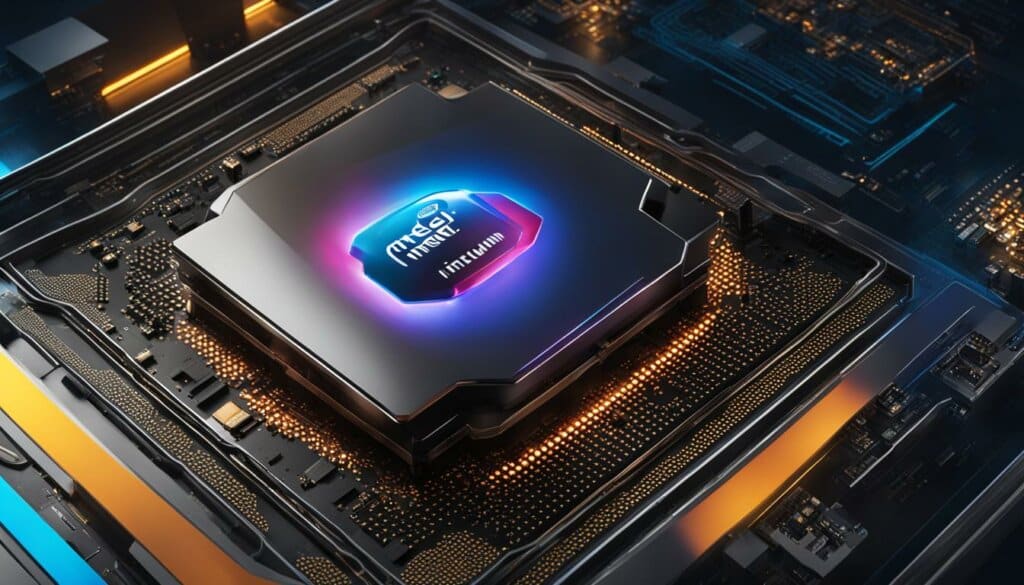
Decoding Intel Processor Names
Intel processors are known for their powerful performance and innovative technologies. To understand the capabilities and performance of Intel processors, it’s important to decode their naming conventions. Each processor name consists of various components that provide valuable insights into its specifications and usage.
Let’s break down the naming conventions:
Brand: Intel offers several processor brands, including Core, Xeon, Pentium, and Celeron. The brand indicates the target market and intended usage of the processor.
Brand Modifiers: For Core processors, there are brand modifiers such as i3, i5, i7, or i9. These modifiers denote the performance level and capabilities of the processor. Higher numbers generally indicate more advanced features and higher performance.
Generation Indicator: Intel releases processors in different generations, each denoted by a specific code name such as Coffee Lake, Ice Lake, or Tiger Lake. Newer generations often bring architectural improvements and increased performance.
SKU Number Sequence: The SKU number sequence represents the unique identifier for each processor model within a specific generation and brand. Higher SKU numbers typically indicate higher clock speeds and more features.
Product Line Suffix: Some processor models have a product line suffix, such as K or U. These suffixes indicate specific variations or characteristics of the processor, such as overclocking capabilities or power efficiency.
Intel Processor Naming Components
| Component | Description |
|---|---|
| Brand | Indicates the target market and usage |
| Brand Modifiers | Denotes the performance level and capabilities |
| Generation Indicator | Represents the specific code name for a generation |
| SKU Number Sequence | Unique identifier within a generation and brand |
| Product Line Suffix | Additional variations or characteristics |
Understanding Intel’s processor naming conventions allows consumers to make informed decisions when choosing a processor that best suits their computing needs. Whether it’s the high-performance Intel Core processors, the reliable Intel Xeon processors for business applications, or the budget-friendly Intel Pentium and Celeron processors, the naming conventions provide valuable insights into the capabilities of each processor model.
The Evolution of Intel Processor Generations
Intel processors are constantly evolving, with each new generation introducing significant performance upgrades and improvements. These generations are characterized by code names like Coffee Lake, Ice Lake, and Tiger Lake. Let’s explore the evolution of Intel processor generations and the advancements they bring.
1st Generation: Nehalem
The Nehalem microarchitecture, released in 2008, marked the beginning of a new era for Intel processors. It introduced features like Turbo Boost Technology and Hyper-Threading, enhancing both single-threaded and multi-threaded performance.
2nd Generation: Sandy Bridge
Sandy Bridge processors, unveiled in 2011, brought improved energy efficiency and integrated graphics capabilities. They also featured the Intel Quick Sync Video technology, enabling fast video encoding and decoding.
3rd Generation: Ivy Bridge
Ivy Bridge, released in 2012, focused on further power efficiency improvements and introduced the Tri-Gate transistor technology. This generation also offered enhanced graphics performance for better gaming and multimedia experiences.
4th Generation: Haswell
Haswell processors, launched in 2013, delivered significant power efficiency gains and introduced advanced instructions for better performance in tasks like multimedia and cryptography.
5th Generation: Broadwell
Broadwell, released in 2014, continued the trend of improved power efficiency and increased graphics performance. This generation also introduced new features like Intel RealSense technology for facial recognition and gesture control.
6th Generation: Skylake
Skylake processors, introduced in 2015, offered better performance, power efficiency, and support for DDR4 memory. They also brought improvements in graphics performance and introduced Thunderbolt 3 technology.
7th Generation: Kaby Lake
Kaby Lake, released in 2016, focused on optimizing performance for 4K video, virtual reality, and gaming. This generation also introduced the Intel Optane memory technology, providing faster data access and system responsiveness.
8th Generation: Coffee Lake
Coffee Lake processors, launched in 2017, brought increased core counts and higher clock speeds. They also introduced Intel Optane memory support and offered improved performance for content creation and gaming.
9th Generation: Coffee Lake Refresh
The Coffee Lake Refresh processors, released in 2018, continued to offer high core counts and increased clock speeds. This generation also introduced enhanced overclocking capabilities and improved thermal performance.
10th Generation: Comet Lake
Comet Lake processors, unveiled in 2019, offered better performance, increased core counts, and support for faster memory speeds. This generation also introduced higher clock speeds and improved integrated graphics.
11th Generation: Tiger Lake
Tiger Lake, released in 2020, brought significant advancements in CPU performance, graphics capabilities, and AI acceleration. This generation also introduced Thunderbolt 4 and Wi-Fi 6 support.
12th Generation: Alder Lake
Alder Lake, expected to be released in 2021, is anticipated to bring a hybrid architecture combining high-performance cores with efficiency cores. This generation aims to deliver significant performance improvements across a wide range of applications.
13th Generation: Raptor Lake
Raptor Lake, planned for release in late 2022, is expected to continue the trend of performance enhancements and efficiency improvements. This generation may bring new features and technologies to further empower users in their computing needs.
| Generation | Release Year | Key Advancements |
|---|---|---|
| Nehalem | 2008 | Turbo Boost and Hyper-Threading |
| Sandy Bridge | 2011 | Improved energy efficiency and integrated graphics |
| Ivy Bridge | 2012 | Tri-Gate transistor technology and enhanced graphics performance |
| Haswell | 2013 | Power efficiency gains and advanced instructions |
| Broadwell | 2014 | Increased power efficiency and graphics performance |
| Skylake | 2015 | Better performance, power efficiency, and Thunderbolt 3 support |
| Kaby Lake | 2016 | Optimized performance for 4K video and Intel Optane memory |
| Coffee Lake | 2017 | Increased core counts and improved content creation performance |
| Coffee Lake Refresh | 2018 | Enhanced overclocking capabilities and improved thermal performance |
| Comet Lake | 2019 | Improved performance and support for faster memory |
Discover the Latest Intel Processors
The world of computing is constantly evolving, and Intel is at the forefront of innovation with its newest processors. Whether you’re a tech enthusiast, a professional, or a casual user, the latest Intel processors offer advanced features and cutting-edge performance to enhance your computing experience.
For mobile PCs, Intel has introduced the 11th Generation Tiger Lake chip, delivering remarkable speed and efficiency. This newest Intel processor is designed to power mobile devices with lightning-fast responsiveness, enabling seamless multitasking and smooth gaming experiences. With the latest Intel Core architecture, the 11th Generation processors offer faster clock speeds, ensuring you can tackle demanding tasks with ease.
On the desktop front, Intel presents the 10th Generation Comet Lake processor. This processor boasts impressive capabilities, making it an ideal choice for desktop PCs. With improved performance and enhanced support for productivity and entertainment, the 10th Generation processors cater to the needs of both professional users and gamers alike.
One of the standout features of the latest Intel processors is their ability to provide longer battery life, ensuring uninterrupted productivity and entertainment on the go. Whether you’re working on important tasks or enjoying multimedia content, you can rely on the efficiency of Intel’s newest processors.
The new Evo platform is also supported by these processors, which offers an optimized and immersive computing experience. The Evo platform combines the hardware and software enhancements of Intel’s latest processors, ensuring a seamless interaction between your device and the applications you use.
Benefits of the Latest Intel Processors
- Advanced features and performance improvements
- Faster clock speeds for enhanced productivity
- Longer battery life for uninterrupted usage
- Support for the new Evo platform
- Seamless multitasking and smooth gaming experiences
As technology continues to evolve, Intel continues to push the boundaries of innovation. The newest Intel processors, including the 11th Generation Tiger Lake chip and the 10th Generation Comet Lake processor, bring exceptional speed, efficiency, and performance to meet the demands of modern computing.
Whether you’re a power user requiring the latest Intel Core processor for intensive tasks, a business professional needing the reliability and accuracy of an Intel Xeon processor, or a casual user looking for an affordable and efficient option like the Intel Pentium processor, Intel has the perfect solution for you.
Stay ahead of the curve and experience the power of the newest Intel processors for yourself, revolutionizing the way you work, play, and create.
Wrapping Up the Newest Intel Processors
The newest Intel processors, including the 14th Generation Core series, are revolutionizing the world of computing with their unmatched performance and cutting-edge features. Whether you’re a passionate gamer, a business professional, or a casual computer user, Intel has a processor tailored to meet your specific requirements.
Intel’s commitment to pushing the boundaries of processing power is evident in each new generation of processors they release. From the latest Intel Core processors to the powerful Intel Xeon processors, Intel delivers innovative solutions that cater to the demands of modern computing.
With the Intel Core processors, you can experience lightning-fast speed and seamless multitasking, while the Intel Xeon processors offer the reliability and performance needed for critical computing applications. For budget-conscious users, the Intel Pentium processors provide a perfect balance of affordability and mid-range performance.
As Intel continues to lead the way in processor technology, each new release brings enhanced features, improved efficiency, and exceptional performance. So, whether you’re looking to upgrade your gaming rig, optimize your business operations, or simply enhance your everyday computing experience, the newest Intel processors are the perfect choice.
FAQ
What are the key specifications and features of the newest Intel processors?
The newest Intel processors, such as the 14th Generation Core series, offer unparalleled performance with cutting-edge features. These processors include high-end models like the Core i9-14900K, Core i7-14700K, and the budget-friendly Core i5-14600K. The top-of-the-line Core i9-14900K boasts impressive specifications and is capable of reaching a 6.0 GHz core frequency without modifications.
What is the purpose of Intel Core processors?
Intel Core processors are the flagship family of CPUs produced by Intel. They provide high-performance computing for various needs, including gaming, business, and everyday tasks. Each new generation of Core processors brings enhanced performance and features, pushing the boundaries of processing power.
What are Intel Xeon processors used for?
Intel Xeon processors are specifically designed for business computing and critical computing applications such as financial or scientific computing. These CPUs offer comparable clock speeds to the Core processors but come with additional features that make them suitable for professional purposes. Xeon processors are known for their support for ECC error-correcting memory, enhancing data processing reliability and accuracy.
What are the features of Intel Pentium processors?
Intel Pentium processors provide mid-range performance at more affordable price points compared to the Core and Xeon processors. They are ideal for everyday computing tasks and applications that do not require intensive processing power. Pentium processors offer similar clock speeds to the Core processors but exclude premium features like Turbo Boost and HyperThreading to keep costs down.
How does Intel name its processors?
Intel processors follow a specific naming convention that includes the brand (such as Core, Xeon, Pentium, or Celeron), brand modifiers (i3, i5, i7, or i9 for Core processors), generation indicator, SKU number sequence, and product line suffix. These naming conventions help identify each processor and provide insights into its capabilities and performance.
What is the significance of Intel processor generations?
Intel processors are released in different generations, each representing significant performance upgrades and improvements. Each generation introduces new features and technologies that enhance productivity, connectivity, and overall performance. It’s important to understand the different generations when choosing an Intel processor for your computing needs.
What are the latest Intel processors available?
The latest Intel processors include the 11th Generation Tiger Lake chip for mobile PCs and the 10th Generation Comet Lake processor for desktops. These processors offer advanced features and performance improvements, such as faster clock speeds, longer battery life, and support for the new Evo platform. The 11th Generation processors, in particular, are highly anticipated for their exceptional speed and efficiency.
Why should I consider the newest Intel processors?
The newest Intel processors, including the 14th Generation Core series, offer unparalleled performance and cutting-edge features for various computing needs. Whether you’re a gamer, a business professional, or a casual computer user, there’s an Intel processor that can meet your requirements. With each new generation, Intel continues to push the boundaries of processing power and deliver innovative solutions for the ever-evolving world of computing.
Source Links
- https://readwrite.com/exploring-intels-14th-generation-core-processors/
- https://en.wikipedia.org/wiki/Intel_Core
- https://www.hp.com/hk-en/shop/tech-takes/post/a-complete-guide-to-intel-processors

